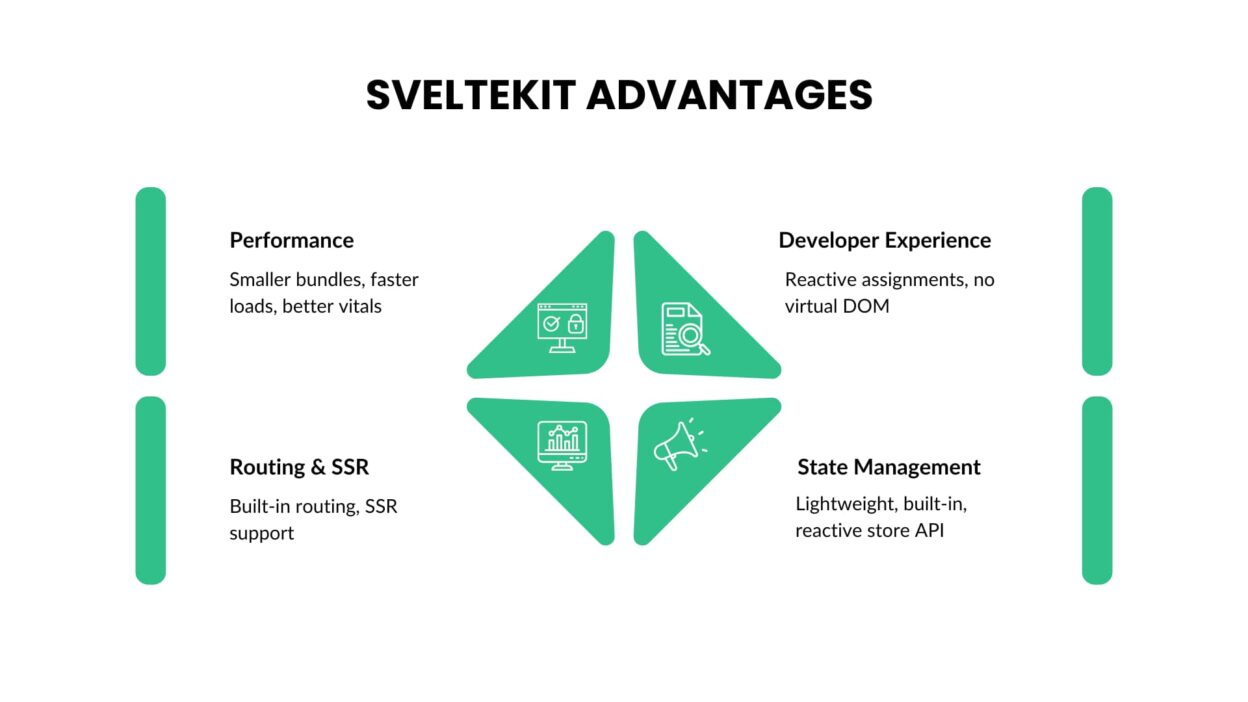Web development has been dominated for years by heavyweight frameworks like React, Angular, and Vue. But in recent times, SvelteKit has emerged as a strong contender—positioning itself as a lightweight, high-performance alternative to React. Developers are increasingly considering SvelteKit for projects where simplicity, performance, and developer experience are top priorities.
In this article, we’ll dive into why SvelteKit is gaining traction, how it compares to React, and what makes it attractive for modern developers.
What is SvelteKit?
SvelteKit is a full-stack framework built on top of Svelte, designed for creating fast and scalable web applications. Unlike traditional frameworks like React, which ship a runtime to the browser, Svelte compiles your code at build time into highly optimized vanilla JavaScript.
SvelteKit extends this concept further by adding features like:
- File-based routing (similar to Next.js)
- SSR (Server-Side Rendering) and SSG (Static Site Generation) support
- API endpoints built directly into the project
- Automatic code-splitting and bundling
- Adapters for deployment (Vercel, Netlify, Cloudflare, etc.)
Why Developers Are Turning to SvelteKit
1. Performance Advantage
React applications often ship a significant runtime bundle to the browser. SvelteKit eliminates this by compiling components at build time, resulting in:
- Smaller bundle sizes
- Faster page loads
- Better Core Web Vitals scores
2. Simplified Developer Experience
React relies on concepts like JSX, useState, and useEffect, which introduce boilerplate and complexity. In contrast:
- SvelteKit uses reactive assignments ($:) instead of hooks.
- No virtual DOM – updates are compiled to direct DOM operations.
- Cleaner syntax reduces learning curve for new developers.
3. Built-In Routing and SSR
Unlike React, which requires additional libraries like React Router or Next.js for SSR, SvelteKit provides:
- Out-of-the-box routing (file-based)
- SSR and SSG support without extra setup
- Dynamic routes and endpoints
This makes SvelteKit closer to an “all-in-one” framework, reducing dependency management.
4. Better State Management
In React, developers often reach for Redux, Zustand, or Context API. SvelteKit offers a store API that is:
- Lightweight
- Built-in
- Reactive out of the box
SvelteKit vs React: A Detailed Comparison
| Feature | SvelteKit | React |
| Rendering | SSR, SSG, CSR out of the box | CSR by default, SSR/SSG via Next.js |
| State Management | Built-in store API | Third-party libraries (Redux, Zustand, etc.) |
| Performance | Compiles to vanilla JS (no runtime) | Relies on virtual DOM runtime |
| Bundle Size | Very small (optimized at build time) | Larger due to runtime overhead |
| Routing | File-based, built-in | Requires React Router or Next.js |
| Developer Experience | Simple syntax, reactive declarations | JSX, hooks, boilerplate |
| Ecosystem | Growing, but smaller than React | Mature, massive ecosystem |
| Deployment | Adapters for Vercel, Netlify, Cloudflare | Wide hosting support via Next.js or CRA builds |
| Learning Curve | Easier for beginners | Moderate to steep (especially with hooks) |
Real-World Use Cases for SvelteKit
- Content-heavy sites: Blogs, documentation, and knowledge bases benefit from SSG and faster load times.
- E-commerce: SSR and hydration make SvelteKit suitable for product catalogs with dynamic data.
- Dashboards and admin panels: Reactive stores and lightweight rendering improve performance on data-heavy UIs.
- Startups and MVPs: Quick setup and faster iterations make SvelteKit attractive for rapid prototyping.
Challenges of Adopting SvelteKit
While SvelteKit is gaining momentum, it’s not without challenges:
- Smaller ecosystem: React’s ecosystem (libraries, UI kits, community support) is still unmatched.
- Talent pool: Fewer developers are proficient in SvelteKit compared to React.
- Enterprise adoption: React remains the default choice for enterprise-scale apps.
Why SvelteKit is SEO-Friendly
SEO is a critical factor for any web application. SvelteKit’s design naturally supports better SEO outcomes compared to React-based SPAs (Single Page Applications):
- Server-Side Rendering ensures search engines can crawl pre-rendered HTML.
- Fast performance and small bundles improve Core Web Vitals, which directly affect rankings.
- Metadata handling is straightforward with svelte:head.
- Static site generation creates crawlable, index-friendly pages.
Future of SvelteKit
The future looks promising for SvelteKit:
- Rising community adoption: More developers and companies are experimenting with it.
- Growing ecosystem: UI libraries, plugins, and integrations are expanding.
- Enterprise interest: As performance becomes a differentiator, enterprises may shift to SvelteKit for certain workloads.
Final Thoughts
SvelteKit is not just a trendy alternative—it’s a serious competitor to React for developers who value speed, simplicity, and SEO. While React remains dominant thanks to its ecosystem and enterprise support, SvelteKit’s performance-first approach and developer-friendly syntax make it one of the most exciting frameworks in modern web development.
If you’re a developer tired of heavy runtimes, boilerplate, and dependency sprawl, SvelteKit might be the lightweight, future-ready alternative you’ve been waiting for.
FAQs
Is SvelteKit production-ready?
Yes. SvelteKit reached 1.0 in December 2022 and is now stable with wide adoption in production projects.
Can SvelteKit replace React entirely?
Not yet. While SvelteKit offers simplicity and performance, React’s ecosystem and community make it irreplaceable for very large, enterprise-scale applications.
Is it easier to learn SvelteKit compared to React?
Yes. Developers find SvelteKit’s syntax more intuitive, especially those new to frontend frameworks.
Does SvelteKit work with TypeScript?
Absolutely. SvelteKit has first-class TypeScript support, making it suitable for large-scale, type-safe applications.


